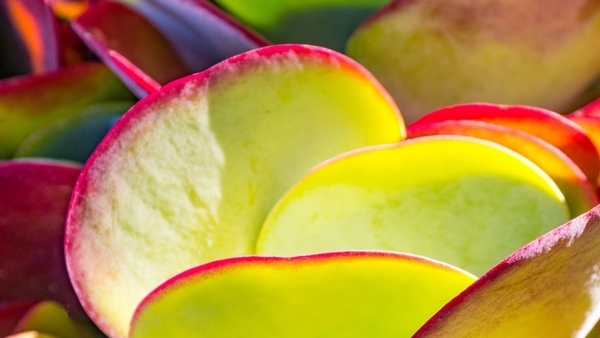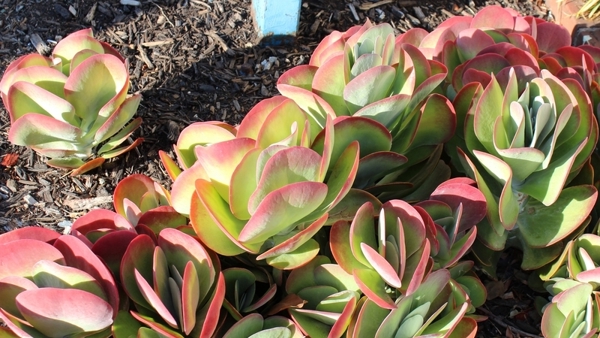Yates Account
Join now
Create a Yates account today!
Sign up to join the Yates Garden Club for monthly e-mails packed with seasonal inspiration, tips for success & exclusive promotions.
Plus if you’re a Garden Club member you can take part in the Yates Growing Community - a blog to share successes, get advice & win prizes in fun challenges along the way!

Forgot password
Enter the email address associated with your account, and we'll email you a new password.

Perfect for first time plant parents, ‘Flapjacks’ (Kalanchoe luciae), provide both stylish looks and a laid back nature any new parent needs. Their green with deep pink tipped paddle like leaves, stand tall on powdery white stems, providing a unique colour contrast in garden beds and pots. Flapjacks just love dry conditions, and don’t need much care to be happy. As long as you give them a well drained soil and plenty of sun, they will keep out of mischief.
How to grow flapjack in your garden
- Choose a sunny spot with well drained soil. Enrich the soil with Yates Thrive Natural Blood & Bone with Seaweed. If the soil is clay based, add gypsum and fork in well.
- Dig the planting hole twice as wide and to the same depth as the root-ball. Remove the plant from the container, gently tease the roots and cut away any circled or tangled roots.
- Position in hole and backfill, gently firming down. Form a raised or doughnut shaped ring of soil around the outer edge of the plant's root zone. This helps keep water where it's needed. Always water in well after planting to settle the soil around the roots and keep the soil slightly moist for several weeks while the new plant establishes.
- Mulch with an organic mulch, such as bark chips or an inorganic mulch like pebbles or stones. Ensure that the mulch is kept away from the base of the plants.
- Water when the soil is dry, this may be once a week, depending on weather and soil conditions.
- Feed your flapjacks once every autumn and spring with Yates Thrive Natural Fish Seaweed+ Plant Food Concentrate.


How to grow flapjacks in a pot
- Choose a pot at least 300mm wide and deep. Position in full sun and partially fill with quality potting mix, such as Yates Thrive Cacti Succulent Potting Mix.
- Remove the plant from the container, gently tease the roots and cut away any circled or tangled roots.
- Position in pot and backfill with potting mix, gently firming down. Water in well.
- Mulch with an organic mulch, such as bark chips or an inorganic mulch like pebbles or stones. Ensure that the mulch is kept away from the base of the plants.
- Water when the soil is dry, this may be once a week, depending on weather and soil conditions.
- Feed your flapjacks once every autumn and spring with Yates Thrive Plant Food Spikes Cacti & Succulents.
Growing tips
- Flapjacks are not fond of water. Avoid sitting them in wet soils as they can suffer from root rot.
- These hardy plants can be grown indoors in a well lit area but away from harsh afternoon sun or reflective light.
- Like many other succulents, Flapjacks can produce terminal or end of life flowers from the centre of the plant. Although this means the end to the larger plant, many pups will appear at the base, waiting to be planted out and shared.
Zygocactus come in many colours and put on one of the most striking floral displays of any plant.
Yucca
Yuccas are striking plants that make a strong impact in the garden. Flowers are commonly white & held on strong stems above the foliage.
Rhipsalis
There is no plant like the Rhipsalis with long cascading green stems create an instant green waterfall wherever they are placed in the home.
Pig Face
Pigface provide an abundance of bright and cheerful flowers in Spring, they also play an important role as a soil stabiliser around our beaches.
Recommended products
Yates Thrive Natural Blood & Bone with Seaweed
A certified organic garden input boosted with NZ Seaweed to gently nourish plants, enrich the soil and encourage a strong healthy root system.
Yates Thrive Natural Fish & Seaweed+ Plant Food Concentrate
A complete plant food enriched with natural fish, seaweed, humates, molasses and more - boosted with NPK to improve plant and soil vitality.
Yates Thrive Cacti & Succulent Potting Mix
Specifically formulated for the successful growing of cacti and succulents, both indoors in pots and outdoors in the garden bed or pots.
Yates Thrive Plant Food Spikes Cacti & Succulents
Yates Thrive Plant Food Spikes Cacti & Succulents are specially designed to feed your cacti & succulents where they need it most, at the roots.
















Share
Share this article on social media